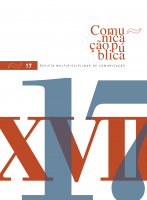World Press Photo 2012
the discursive construction of the Arab Spring
DOI:
https://doi.org/10.4000/cp.934Keywords:
Photojournalism, World Press Photo, discursive construction, Arab SpringAbstract
This article aims to analyze how the Arab Spring phenomenon was represented in the award-winning photographs of the World Press Photo contest in 2012.
Although news photographs are usually seen as indexes of the real, they often limit the perception of individuals and influence their social practices.
Also the winning photographs in 2012 of the World Press Photo, one of the most prestigious photojournalism contests, do not escape the discursive constructivism that shapes the representation and perception of events.
Drawing from critical discourse analysis, namely from the theoretical tools of barthesian semiotics and Gunther Kress’s and Theo van Leeuwen’s social semiotics, we sought to interpret the 38 award-winning photographs of the World Press Photo contest in 2012, in order to reflect on the way they have contributed to our understanding of the Arab Revolt and aroused our interest and imagination to the unfolding of the conflict.
Downloads
References
Barker, C., Galasinski, D. (2001). Cultural Studies and Discourse Analysis. London: Sage.
Barthes, R. (2009a). A Mensagem Fotográfica. In: Barthes, R. (ed). O Óbvio e o Obtuso. Lisboa: Edições 70, pp.11-26.
Bird, S. Elizabeth & Dardenne, Robert W. (1993). Mito, Registo e ‘Estórias’: Explorando as Qualidades Narrativas das Notícias. In: Traquina, N. (ed). Jornalismo: Questões, Teorias e ‘Estórias’. Lisboa: Vega, pp. 263-277.
_____(2009). Rethinking News and Myth as Storytelling. In: Wahl-Jorgensen, K., Hanitzsch, T. ed. The Handbook of Journalism Studies. London, Routledge, pp. 205-217.
Campbell, J. (1991). The Power of Myth. New York: Anchors.
Carvalho, A. (2008). Media(ted) Discourse and Society – Rethinking the Framework of Critical Discourse Analysis. Journalism Studies. 9 (2), pp. 161-177.
Cirlot, J.E. (2001). A Dictionary of Symbols. London: Routledge. DOI : 10.4324/9780203133750
Coman, M. (2005). News Stories and Myth – The Impossible Reunion?. In: Rothenbuhler E., Coman, M. (ed). Media Antropology. California: Sage, pp. 111-120.
Dabashi, H. (2012). The Arab Spring: The End of Postcolonialism London, Zed Books.
Ettema, J. S., & Glasser, T. L. (1988). Narrative Form and Moral Force: The Realization of Innocence and Guilt Through Investigative Journalism. Journal of Communication. 38 (3), pp. 8-26. DOI : 10.1111/j.1460-2466.1988.tb02057.x
Fairclough, N. (1995). Media Discourse. London: Hodder Arnold.
Freund, G. (1995). Fotografia e Sociedade. Lisboa: Vega.
Gelvin, J. L. (2012). The Arab Uprisings: What Everyone Needs to Know. New York: Oxford.
Hall, S. (1997). Representation, Cultural Representations and Signifying Practices. London: Sage.
Kress, G., van Leeuwen, T. (2000). Reading Images: The Grammar of Visual Design. London: Routledge. DOI : 10.4324/9780203619728
Lexicon, H. (1990). Dicionário de símbolos. São Paulo: Cultrix.
Lule, J. (2001). Daily News, Eternal Stories: The Mythological Role of Journalism. New York: Guilford Press.
Lundelin, K. (2012). World Press Photo 2012. London: Thames & Hudson.
Lynch, M. (2012). The Arab Uprising: The Unfinished Revolutions on the New Middle East. New York: Public Afffairs.
Newhall, B. (2002). Historia de la Fotografia. Barcelona: Gustavo Gilli.
Noueihed, L., Warren, A. (2012). The Battle for the Arab Spring: Revolution, Counter-Revolution and the Making of a New Era. London: Yale University Press.
Orgad, S. (2012). Media Representation and Global Imagination. Cambridge: Polity Press.
Peirce, C. (1931). Collected Papers of Charles Sanders Peirce. Cambridge, Massachussetts: Harvard University Press.
Ritchin, F. (1994). La Proximité Du Témoignage – Les Engagements du photojournaliste. In : Frizot, M. (ed). Nouvelle Histoire de la Photographie. Paris: Bordas, pp. 591-611.
Roeh, I. (1989). Journalism as Storytelling, Coverage as Narrative. American Behavioral Scientist, 33 (2), pp. 162-168. DOI : 10.1177/0002764289033002007
Sontag, S. (2012). Ensaios sobre Fotografia. Lisboa: Quetzal.
Traquina, N. (1993). As Notícias. In: Traquina, N. (ed). Jornalismo: Questões, Teorias e ‘Estórias’. Lisboa: Veja, pp. 167-176.
van Gorp, B. (2010). Strategies to Take Subjectivity out of Framing Analysis. In: D’Angelo, P., Kuypers, J. (ed). Doing News Framing Analysis: Emperical and Theoretical Perspectives. London: Routledge, pp. 84-109.
Wodak, R. & Meyer, M. (2009). Critical Discourse Analysis: History, Agenda, Theory and Methodology. In: Wodak, R., Michael, M. (ed). Methods of Critical Discourse Analysis London: Sage, pp. 1-33.
Zelizer, B. (2010). About to Die: How News Images Move the Public. New York, Oxford: Oxford University Press.
_____(2012). A Voz do Visual na Memória. Revista Media & Jornalismo, nº20, pp.19-42.
Bibliografia Online
Campbell, David (2008). Photojournalism: Living with Questions and Tensions. Foto 8. Disponível em: <http://www.foto8.com/live/photojournalism-living-with-questions-and-tensions/> (Consultado a 15 de Outubro de 2014).
Moura, V. G. (2012). Pietà. Diário de Notícias. Disponível em:
<http://www.dn.pt/inicio/opiniao/interior.aspx?content_id=2305146&seccao=Vasco%20Gra%E7a%20Moura&tag=Opini%E3o%20-%20Em%20Foco,%20Consultado%20a%202%20de%20setembro%20de%202013.> (Consultado a 11 de Setembro de 2013).
Motta, L. G. (2003). O Jogo entre Intencionalidades e Reconhecimentos: Pragmática Jornalística e Construção de Sentidos. Comunicação e Espaço Público, Ano VI nº 1 e 2, pp. 7-38. Disponível em: <http://repositorio.unb.br/handle/10482/12249> (Consultado a 11 de Setembro de 2013).
Sousa, J. P. (2002). Fotojornalismo: Uma Introdução à História, às Técnicas e à Linguagem da Fotografia na Imprensa. Disponível em: <http://www.bocc.ubi.pt/pag/sousa-jorge-pedro-fotojornalismo.pdf > (Consultado a 11 de Setembro de 2013).
Shafer, J. (2011). Deadly Images A Q&A with Barbie Zelizer. Slate. Disponível em:
<http://www.slate.com/articles/news_and_politics/press_box/2011/01/deadly_images.single.html> (Consultado a 11 de Setembro de 2013).
World Press Photo (s.d.) World Press Photo Exhibition. Disponível em:
<http://www.worldpressphoto.org/exhibition> (Consultado a 11 de Setembro de 2013).
World Press Photo (s.d.) 2012 Photo Contest. Disponível em:
<http://www.worldpressphoto.org/gallery/2012-photo-contest> (Consultado a 11 de Setembro de 2013).
World Press Photo (2013) Samuel Aranda. Vimeo. Disponível em:
<http://vimeo.com/43816585> (Consultado a 11 de Setembro de 2013).
World Press Photo (2013) Aidan Sullivan on the World Press Photo of the Year 2011. Vimeo. Disponível em: < http://vimeo.com/67505413> (Consultado a 11 de Setembro de 2013).
Downloads
Published
Issue
Section
License
Copyright (c) 2015 Direitos do Autor (c) 2015

This work is licensed under a Creative Commons Attribution-NonCommercial 4.0 International License.
Os conteúdos da Comunicação Pública estão licenciados com uma licença Creative Commons - Atribuição-NãoComercial 4.0 Internacional.


